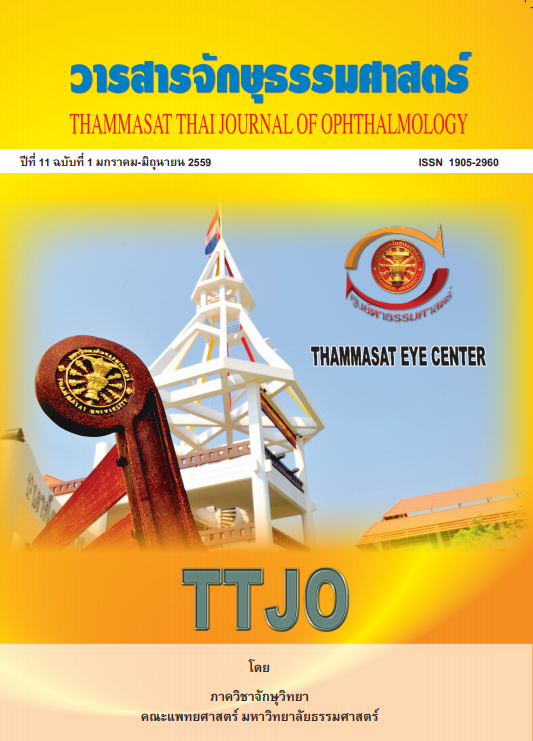น้ําในลูกตา เครื่องมือวัดความดันตาและความดันตา 24 ชั่วโมง
Main Article Content
Abstract
บทคัดยอ
ความดันที่เกิดขึ้นในตาเปนผลจากสมดุลของการสรางและการระบายออกของสารน้ํา (aqueous humor) ที่ไหลเวียนอยูภายในลูกตาและเกิดขึ้นตลอดเวลา แมจะมีตัวเลขชัดเจนในแงของอัตราการผลิต aqueous humor ที่แนนอน แตในความเปนจริงกลับพบวา การสราง aqueous humor ระหวางวันไมคงที่ และเปนกระบวนการทางชีวภาพที่มีความสัมพันธโดยตรงกับสมดุลการทํางานของระบบตางๆ ของรางกายใน แตละวัน (circadian rhythms) หรือที่เรียกอีกชื่อวา นาฬิกาชีวภาพ (biological clocks) ตอหินเปนกลุมโรค ของเสนประสาทตาชนิดหนึ่งที่ทําใหเกิดภาวะตาบอดถาวรอันดับตนๆ ของโลก แมวา IOP จะไมนับเปนสวน หนึ่งของนิยามหรือเกณฑการวินิจฉัยโรคนี้แลวดังในอดีต แต IOP ก็เปนปจจัยเสี่ยงเพียงอยางเดียวที่สามารถ ควบคุมไดและเปนเปาหมายของการรักษาในระยะยาว การวัด IOP ดวยเครื่องมือที่เหมาะสม มีประสิทธิภาพ แมนยํา สะดวกและปลอดภัยจึงเขามามีบทบาทในการประเมิน รวมถึงการวัดความดันตา 24 ชั่วโมงที่ใหขอมูล มากกวาการวัด IOP เมื่อพบแพทยเพียงครั้งเดียว ชวยแสดงใหเห็นถึงการเปลี่ยนแปลงของ IOP ระหวางวัน รวมถึงความแตกตางของ IOP ระหวางชวงเวลากลางวันและกลางคืนในผูปวยแตละราย ซึ่งเปนประโยชนตอ การวินิจฉัยโรคตอหินและการติดตามการรักษาในขั้นตอนตอไป
Article Details
References
Aqueous humor formation. Available from: http://www.aao.org/bcscsnippetdetail.aspx?id=591e80ab-e372-4ad3-9c49-1aed4ba74f61
Duke-Elder S, Jay B. Diseases of the lens and vitreous; glaucoma and hypotony. In: DukeElder S, ed. System of Ophthalmology, vol. 11. St. Louis, MO: Mosby; 1969.
Stamper RL. A history of intraocular pressure and its measurement. Optom Vis sci. 2011; 88(1):E16-28.
Liu JH, Kripke DF, Twa MD, Hoffman RE,Mansberger SL, Rex KM, et al. Twenty-four hour pattern of intraocular pressure in the aging population. Invest Ophthalmol Vis Sci. 1999; 40:2912-2917.
Liu JH, Zhang X, Kripke DF, Weinreb RN. Twenty four-hour intraocular pressure pattern associated with early glaucomatous changes. Invest OphthalmolVis Sci. 2003; 44:15861590.
Barkana Y, Anis S, Liebmann J, Tello C, Ritch R. Clinical utility of intraocular pressure monitoring outside of normal office hours in patients with glaucoma. Arch Ophthalmol. 2006; 124:793-797.
Mosaed S, Liu JH, Weinreb RN. Correlation between office and peak nocturnal intraocular pressures in healthy subjects and glaucoma patients. Am J Ophthalmol. 2005; 139:320324.
Hattenhauer MG, Johnson DH, Ing HH, Herman DC, Hodge DO, Yawn BP, et al. The probability of blindness from open-angle glaucoma. Ophthalmology. 1998; 105:20992104.
Mansouri K. The road ahead to continuous 24-hour intraocular pressure monitoring in glaucoma. J Ophthalmic Vis Res. 2014; 9(2):260-8.
Theofylaktopoulos I, Diestelhorst M, Krieglstein GK. Self-tonometry with the Ocuton S versus Goldmann tonometry. Graefes Arch Clin Exp Ophthalmol. 1999; 237(9):720-724.
Rai S, Moster MR, Kesen M, et al. Level of disagreement between Proview phosphene tonometer and Goldmann applanation tonometer intraocular pressure readings. J Glaucoma. 2005; 14(2):120-123.
SENSIMED Triggerfish® Available from: http://www.sensimed.ch/en/sensimedtriggerfish/sensimed-triggerfish.html
Mansouri K, Medeiros FA, Tafreshi A, Weinreb RN. Continuous 24-Hour monitoring of intraocular pressure patterns with a contact lens sensor: safety, tolerability, and reproducibility in patients with glaucoma. Arch Ophthalmol. 2012; 13:1-6.
Mansouri K, Shaarawy T. Continuous intraocular pressure monitoring with a wireless ocular telemetry sensor: initial clinical experience in patients with open angle glaucoma. Br J Ophthalmol. 2011; 95(5):627-9.
Collins SL, Moore RA, McQuay HJ. The visual analogue pain intensity scale: what is moderate pain in millimetres? Pain. 1997; 72(1-2):95-7.
Smart, Continuous Monitoring of Intra-Ocular Pressure with Triggerfish Contact Lens: Q&A with René Goedkoop, CMO of Sensimed. Available from: http://www.medgadget.com/2013/07/smart-continuous-monitoring-of-the-intra-ocularpressure-with-the-triggerfish-contact-lens-qa-with-rene-goedkoop-cmo-of-sensimed.html
CE Marking Countries. Available from: http://www.export.gov/cemark/eg_main_017269.asp


